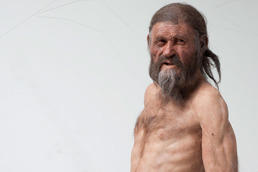Fuente: Freie Universität Berlin - Freie Universität Berlin
Expuesto el: lunes, 13 de agosto de 2012 12:28
Autor: Freie Universität Berlin - Freie Universität Berlin
Asunto: Prehistoric Growth Spurts
Ötzi, the 5300-year-old mummy discovered in 1991 in the Ötztal Alps, is thought to have been 160 cm in size. The stature of prehistoric humans can be calculated, based on their long bones. Source: Reconstruction by Kennis © South Tyrol Museum of Archaeology, Augustin Ochsenreiter 08/13/2012 “Ötzi the Iceman,” whose 5,300-year-old mummy was discovered in the Alps in 1991, is supposed to have been just 160 cm, or 5’3”, tall. Alexander the Great, king of ancient Macedonia, was even shorter, at 150 cm, or 4’11”. Nowadays, the average height for men in Germany is 1.8 meters (about 5’11”) and for women it is about 1.7 meters (about 5’7”). It is frequently said that technological advances have brought greater prosperity, which in turn has caused people to grow taller. A team headed by archaeologist Dr. Eva Rosenstock is taking this as a point of departure in studying data on people’s height – instead of other indicators of affluence, such as GDP. In their activities, the researchers are studying people’s growth during the prehistoric period – at the dawn of human history. Eva Rosenstock traces the rise in average height to the available supply of protein: “Proteins are the strongest factor supporting the development of bodily structures.” Since the Industrial Revolution, systematic records have been kept, documenting human height; the cause of the steady increase that occurred over the 19th and 20th centuries in the Western world, Rosenstock says, is probably the improved availability of protein. “Now we aim to look at the existing archaeological data on nutrition, subsistence strategy, and living conditions during prehistory in the light of how human height developed,” the archaeologist says. The project is receiving about a million euros in funding from the German Research Foundation (DFG) as an Emmy Noether junior research group and is initially slated to run for four years. Working with two doctoral candidates, a statistician, and two students, the project manager has been studying the living conditions and biological standard of living of prehistoric people in the Middle East and Europe at the Institute of Prehistoric Archaeology in Berlin’s Dahlem district since September 2011. “We reconstruct the height of prehistoric people by studying skeletons, especially the lengths of long bones such as the femur, or thighbone,” Rosenstock explains. To do so, her research group initially uses a database from the 1970s that offers access to data on about 5,000 individuals. The goal, though, is to analyze data on 30,000 individuals: Ultimately, Rosenstock and her team plan to reconstruct human living conditions over a long time span – from 40,000 B.C. to the end of the Bronze Age, about 1,000 years before the start of the Western calendar. That means they still have a lot to do. Rosenstock is confident about the initial results: “People had hardly settled into the Neolithic period before they apparently grew shorter.” In the emergent agrarian societies, humans ate primarily grains, without much available protein. Domestication of animals and cultivation of legumes improved the supply of protein, Rosenstock says, and average height rose. “As Neolithic cultures spread, however, people got shorter again,” she says, describing the team’s findings. “That might be because a population increase meant less food for a large number of children.” During the Bronze Age, people were already cultivating fields using plows and oxen – and average heights rose again. This last phase, Rosenstock says, also shows that the evaluation has to include various other factors in addition to diet: “Physical height is the result of net nutrition.” Physical activity, climate, and disease can also rob the body of energy, leaving less fuel for growth. Of course, a human body can only grow as tall as its genetically determined maximum height, even with optimum net nutrition, and height measurements taken from skeletons have been shown to reflect only an individual’s nutrition during childhood and adolescence, since growth ends at that point. Still, Rosenstock’s study of biological standards of living offers access to the only globally comparable indicator of prosperity during prehistory and early history. The same factor could also be applied today: One study has shown that children from socially disadvantaged families tend to be shorter overall. David Bedürftig Further Information Dr. Eva Rosenstock, Freie Universität Berlin, Department of History and Cultural Studies / Institute of Prehistoric Archaeology, Tel.: +49(0)30 / 838-57424, Email: rsnstck@zedat.fu-berlin.de Last Update 08/17/2012 Please enable JavaScript in Your browser.
|

